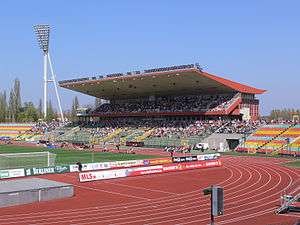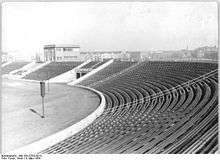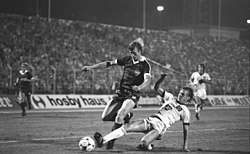Friedrich-Ludwig-Jahn-Sportpark
The Friedrich-Ludwig-Jahn-Stadion at the Friedrich-Ludwig-Jahn-Sportpark is a sports stadium in the Prenzlauer Berg locality in Berlin. It is bordered on the south by Eberswalder Straße, on the north by the Max Schmeling Halle, on the west by Mauerpark, where part of the Berlin Wall once stood. The complex includes a football and athletics stadium as well as several smaller sports fields. With a capacity of approximately 20,000 seats, 15,000 which are covered, the stadium is the third largest in the city after Berlin's Olympiastadion and Stadion An der Alten Försterei. The stadium has been used temporarily by various Berlin football sides, BFC Dynamo currently being the primary tenant of the stadium, following its 2014 advance to the Regionalliga Nordost.[1] Other tentants are VSG Altglienicke and Berlin Adler. Friedrich-Ludwig-Jahn-Sportpark was the venue for the 2018 World Para Athletics European Championships.
 | |
| Former names | Berliner Sportpark (1951-1952) |
|---|---|
| Location | Cantianstraße 24, D-10437 Berlin, Germany |
| Coordinates | 52°32′35″N 13°24′19″E |
| Public transit | Eberswalder Straße. |
| Owner | State of Berlin |
| Capacity | 19,708 |
| Record attendance | 30,000 (East Germany-Belgium, 13 March 1974) |
| Field size | 110 × 72 |
| Surface | Grass |
| Construction | |
| Opened | 1 October 1952 |
| Renovated | 1964, 1970, 1986-1987, 1998, 2015 |
| Architect | Rudolf Ortner |
| Tenants | |
| BFC Dynamo VSG Altglienicke Berlin Adler 1. FC Union Berlin (2008–2009) | |
History

Since 1825, the area was used as the drill grounds of the Guard Regiment of the Prussian army. Some housing was constructed on the site late in the 19th century, but this was a short-lived use and the area soon became an open space used for sports. Between 1892 and 1904, the site served as the ground of Hertha BSC. The city of Berlin purchased the land in 1912 and developed it for sports use in 1913.
After World War II and the division of the capital city, the area was part of what became East Berlin, in the Soviet zone of occupation. A football and athletics stadium, with a capacity of 30,000 spectators, was built on the site in 1951, for use during the World Youth Festival that year. Known initially as Berliner Sportpark, East German municipal officials renamed the facility the Friedrich-Ludwig-Jahn-Sportpark the following year, to honour the centenary of the birth of the man known in Germany as the father of gymnastics. The stadium was refurbished in 1988 and its capacity reduced to the present-day number.
Use of the site
From 1963 to 1989, the facility hosted the Olympic Day of Athletics competition, modeled on a similar event staged each year in West Berlin. The meet saw the setting of several world records, including Uwe Hohn's record javelin throw of 104.80 meters on 20 July 1984 – the first time a throw of over 100 meters was made.

East German first division club BFC Dynamo played its DDR-Oberliga home fixtures here. The wine-reds celebrated nine of its ten consecutive championships (1979 through 1988) in the stadium, except for the 1986-87 season when the stadium was under reconstruction and the club played its matches at the Dynamo-Stadion im Sportforum. In the 1970s and 1980s, BFC Dynamo hosted teams such as Red Star, Aston Villa, Hamburger SV, AS Roma, Werder Bremen and Girondins Bordeaux for its European Cup matches in the stadium.
The national side played ten international matches at the stadium between 1951 and 1990, including its 13 March 1974 contest versus Belgium, which ended with a 5–2 victory in front of a record 30,000 spectators.
The stadium was used by the Berlin Thunder of the NFL Europe during 1999-2002. The amateur side of Hertha BSC (Hertha BSC II) also use the facility, when they expect an unusually large crowd or where there are security concerns related to a match. The final of the Berlin Cup is also held here each season.
In 2006 Hertha BSC played its UEFA Intertoto Cup semi-final match against FK Moscow (0–0) here, as well as its UEFA Cup qualification home contest against Georgian club FC Ameri Tbilisi (1–0). In 2016 Hertha played their Europa League qualification match against Brondby at the stadium and won 1-0, however Hertha lost the corresponding fixture away from home 3-1 and were knocked out of the competition.
The facility also serves as a concert venue and has welcomed performers such as Michael Jackson during his Dangerous World Tour on 4 September 1992, which was watched by 35.000 people.
In May 2001 stadium hosted the 2001 Speedway Grand Prix of Germany, first GP event at temporary track. The Grand Prix was won by Pole Tomasz Gollob, top German rider, Robert Barth, finished 14th.
In July 2014 it was announced that the Friedrich-Ludwig-Jahn-Sportpark was chosen as the venue for the 2015 UEFA Women's Champions League Final. The final was held on 14 May 2015.[2]
The stadium is also regularly used for American football and serves as the home venue for the Berlin Adler. It is also the annual venue of the German Bowl since 2012 and was the site of the 2014 Eurobowl final, where the Berlin Adler defeated the New Yorker Lions 20-17.
Future redevelopment
The stadium is considered to be in a state of decay, satisfying neither current needs nor future plans. In order to host the 2015 UEFA Women's Champions League final, the stadium was temporary renovated at an estimated cost of €1.5 million - €2 million. This temporary renovation included new paintwork, refurbished player and visitor facilities, a new fire alarm system and a new lawn. That was however only the beginning, as the entire area is planned for a future complete redevelopment.
The area is highly popular and the needs for sporting facilities in Berlin are many. Even when the stadium is empty, the area around is crowded. The neighboring Mauerpark is popular among the citizens of Berlin. Its flea market attracts more than 40,000 visitors each Sunday.[3] The population pressure of Prenzlauer Berg is also high, with Pankow having the highest birth rate in Berlin.[4] In preparation for the plans, more than 40 users of sport facilities in Berlin have been interviewed.[4]
Being the second largest stadium in the city, in terms of seating capacity, and with the Olympic Stadium often considered too large, the stadium also plays a crucial role for the possibility of arranging major sports events in Berlin.[5] A redeveloped stadium would fit in Germany's bid for hosting the 2024 Summer Olympics or 2028 Summer Olympics.[4] If Berlin is awarded the 2024 Summer Olympics, the stadium is planned to be the center of the Paralympics.[6]
According to a preliminary draft concept, the redeveloped Friedrich-Ludwig-Jahn-Sportpark is to be an inclusion sports facility, which goes beyond simple accessibility. The plan includes new office spaces for associations and clubs in the grandstand of the stadium and in new buildings, and possibly a new sports hall for clubs and schools with two or three pitches, one or two artificial turf fields, additional tennis, beach volleyball and beach football fields. Further plans includes a day care center and a car park that could possibly also serve the popular Max-Schmeling-Halle.[4]
In January 2015, it was reported that the entire cost for the redevelopment of the whole area was estimated at up to €150 million. The redeveloped stadium will have a capacity of 20,000 spectators and offer future second division fit. The stadium will have soil heating, completely new seats, fully covered stands and become barrier-free. The distinctive floodlights will be preserved.[7]
In February 2015 it was reported by the Berliner Zeitung that the Senate of Berlin wants to rebuild the stadium, and that the reconstruction could begin at earliest in 2018 and be completed by 2023.[8] In February 2017, German media reported that the senate is planning to invest €170 million in the redevelopment of the area, including €85 million for a new stadium, and that the current stadium will be demolished by 2020.[9]
Location and transport
The stadium is located in Berlin, in the locality of Prenzlauer Berg, which forms the southern part of the borough of Pankow. The stadium can be reached via the U-Bahn line U2, station Eberswalder Straße, and via the tramway lines M1, M10 and 12.
Gallery
 The Main stand in 2014.
The Main stand in 2014. The distinctive floodlights.
The distinctive floodlights. The stadium with the Fernsehturm Berlin in the background.
The stadium with the Fernsehturm Berlin in the background.
Panorama
See also
References
- http://www.fupa.net/berichte/bfc-dynamo-zieht-in-jahn-sportpark-um-137303.html
- http://www.uefa.com/womenschampionsleague/news/newsid=2123817.html
- Bardow, Dominik (11 August 2014). "Was wird aus dem Jahnsportpark? - Wende im Gelände". Der Tagesspiegel (in German). Berlin: Verlag Der Tagesspiegel GmbH. Retrieved 31 October 2015.
- Bardow, Dominik (11 August 2014). "Umbaupläne: Jahnsportpark soll barrierefrei werden". Der Tagesspiegel (in German). Berlin: Verlag Der Tagesspiegel GmbH. Retrieved 1 December 2015.
- Wenck, Dietmar (17 August 2013). "Jahn-Sportpark soll für 30 Millionen Euro saniert warden". Berliner Morgenpost (in German). Berlin: Berliner Morgenpost GmbH.
- "Umbaupläne für Berliner Jahn-Sportpark". stadionwelt.de (in German). Stadionwelt, Sole trader: Thomas Krämer. 23 January 2015. Retrieved 31 October 2015.
- Biekler, Sabine; Loy, Thomas (22 January 2015). "Olympia: 150 statt 30 Millionen Euro für Jahn-Sportpark". Der Tagesspiegel (in German). Berlin: Verlag Der Tagesspiegel GmbH. Retrieved 31 October 2015.
- Aulich, Uwe (2 February 2015). "Jahn-Sportpark wird auch ohne Olympia neu gebaut". Berliner Zeitung (in German). Berlin: Berliner Verlag GmbH. Retrieved 31 October 2015.
- Koch-Klaucke, Norbert (23 February 2017). "Senat pumpt 170 Mio. in den Sportpark in Prenzlauer Berg". Berliner Kurier (in German). Berlin: Berliner Verlag GmbH. Retrieved 6 August 2017.
External links
| Wikimedia Commons has media related to Friedrich-Ludwig-Jahn-Sportpark. |
| Preceded by Estádio do Restelo Lisbon |
UEFA Women's Champions League Final venue 2015 |
Succeeded by Mapei Stadium – Città del Tricolore Reggio Emilia |
